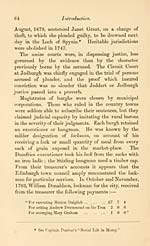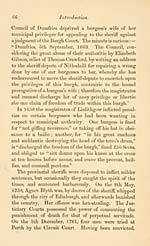Grampian Club > Scotland, social and domestic
(71) Page 65
Download files
Complete book:
Individual page:
Thumbnail gallery: Grid view | List view

Introduction. 65
On the 10th December, 1538, the magistrates of
Haddington sentenced one Howra or Hume, for an act
of theft, " to be bundyn at the erss of ane cart, and to
gang trow all the streittis of the town, and the lockman
to stryik hym with ane vand, and that the servands se
that he execut his office on him and to haif ane fresche
vand at ylk streit end and to forsweir the towne and
obliss him to be hangit be the sheriff and ever he cum
in the towne again."
Humanity had not made much progress among burgh
magistrates after the lapse of two centuries, for the
magistrates of Elgin, in 1700, paid their marshal twenty
shillings, Scots, for " scourging two, lugging two, and
burning two thieves." The punishment of " lugging,"
or depriving the criminal of his ears, was inflicted only
on serfs or notorious felons. Branding was a common
punishment ; it was inflicted chiefly by the regality
courts. The branding iron of Dunfermline was a rod
two feet long, having a square lump of iron at the end,
on which were engraved the letters Dun + Reg —
Dunfermline Regality. The square end of the instru-
ment was made hot and then thrust against the brow
or right hand of the offender. The impression could
not be obliterated.
Females were branded on the cheek by an instrument
called the key. The Burgh Records of Haddington
contain the following : —
" 29th Octr. 1544. The qlk. day, Issobell Gowinlock was ordainit
to be banist the towne fdfr steling of Patrik Shairpis caill, and gyf evir
sche cum in it againe the key to be sett on her cheik."
Burgh magistrates inflicted severe penalties on those
who refused their jurisdiction. In 1663 the Town
On the 10th December, 1538, the magistrates of
Haddington sentenced one Howra or Hume, for an act
of theft, " to be bundyn at the erss of ane cart, and to
gang trow all the streittis of the town, and the lockman
to stryik hym with ane vand, and that the servands se
that he execut his office on him and to haif ane fresche
vand at ylk streit end and to forsweir the towne and
obliss him to be hangit be the sheriff and ever he cum
in the towne again."
Humanity had not made much progress among burgh
magistrates after the lapse of two centuries, for the
magistrates of Elgin, in 1700, paid their marshal twenty
shillings, Scots, for " scourging two, lugging two, and
burning two thieves." The punishment of " lugging,"
or depriving the criminal of his ears, was inflicted only
on serfs or notorious felons. Branding was a common
punishment ; it was inflicted chiefly by the regality
courts. The branding iron of Dunfermline was a rod
two feet long, having a square lump of iron at the end,
on which were engraved the letters Dun + Reg —
Dunfermline Regality. The square end of the instru-
ment was made hot and then thrust against the brow
or right hand of the offender. The impression could
not be obliterated.
Females were branded on the cheek by an instrument
called the key. The Burgh Records of Haddington
contain the following : —
" 29th Octr. 1544. The qlk. day, Issobell Gowinlock was ordainit
to be banist the towne fdfr steling of Patrik Shairpis caill, and gyf evir
sche cum in it againe the key to be sett on her cheik."
Burgh magistrates inflicted severe penalties on those
who refused their jurisdiction. In 1663 the Town
Set display mode to: Large image | Transcription
Images and transcriptions on this page, including medium image downloads, may be used under the Creative Commons Attribution 4.0 International Licence unless otherwise stated. ![]()
| Publications by Scottish clubs > Grampian Club > Scotland, social and domestic > (71) Page 65 |
|---|
| Permanent URL | https://digital.nls.uk/81897536 |
|---|
| Description | Note: Numbers 24-41 are relative to but not part of the Club's series. |
|---|---|

